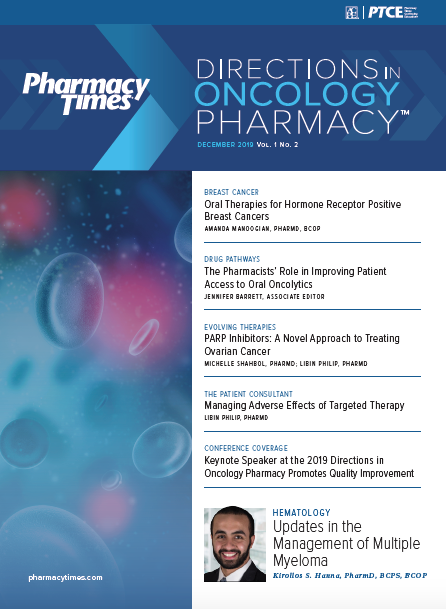Publication
Article
Pharmacy Practice in Focus: Oncology
Treatment Advances Improve Care for Relapsed and Refractory Follicular Lymphoma and Mantle Cell Lymphoma
Author(s):
The 2019 Directions in Oncology Pharmacy™ conference included a session covering relapsed and refractory follicular lymphoma (FL) and mantle cell lymphoma (MCL).
The World Health Organization has identified more than 60 specific subtypes of non-Hodgkin lymphoma that require careful treatment consideration. Researchers have made tremendous progress in treating these diseases, and death rates have fallen an average of 2.2% every year since 2007. Regardless, relapsed or refractory B-cell non- Hodgkin lymphoma (NHL) is a clinical conundrum. The 2019 Directions in Oncology Pharmacy™ conference included a session covering relapsed and refractory follicular lymphoma (FL) and mantle cell lymphoma (MCL).
The session, presented by Kirollos S. Hanna, PharmD, BCPS, BCOP, an assistant professor of pharmacy at Mayo Clinic College of Medicine in Rochester, Minnesota, and a hematology/oncology clinical pharmacist at the University of Minnesota Medical Center in Minneapolis, was well received. Dr Hanna gave a brief overview of non-Hodgkin lymphoma, including signs and symptoms, major subtypes, and specific information about FL and MCL.
FL and MCL differ in a few key features. First, FL is usually associated with a t(14;18) translocation that leads to the regulated expression of BCL-2, and many indolent forms of FL may not require treatment for years. In comparison, MCL manifests after t(11;14) translocation that leads to overexpression of cyclin D1. It is considerably more aggressive than FL, and more aggressive than other indolent lymphomas. Outcomes tend to be worse for individuals of older age, poorer performance status, those with high serum lactate dehydrogenase, white blood cell counts, or Ki-67 scores.
Dr Hanna covered decision-making pathways for both lymphomas and demonstrated to the participants that a number of factors must be considered. In the case of relapsed or refractory FL, selection of a second line and subsequent therapy is especially complex. Fortunately, clinicians can work with patients and, based on specific patient and disease factors, select from a rather large assortment of preferred regimens. Dr Hanna shared evidence for the use of combination lenalidomide and rituximab, and increasing data for use of the phosphoinositide 3-kinase (PI3K) inhibitors after patients have been treated with 2 therapies. The PI3K inhibitors include idelalisib, copanlisib, and duvelisib.
Despite the availability of treatments, at least 20% of patients with FL experience early relapse, meaning that they relapse within 2 years of their frontline treatment. Some of the problems that researchers have identified include drug resistance, and clinicians often struggle to deal with patients who have cumulative toxicities. These problems define the unmet need in relapsed or refractory FL. Dr Hanna spent a few minutes reviewing the currently approved PI3K inhibitors, with an emphasis on administration, dosing, and boxed warnings. The 2 oral PI3K inhibitors, idelalisib and duvelisib, each have boxed warnings. Copanlisib is administered as an intravenous infusion and has relatively similar adverse effects as its oral counterparts, in addition to a reported incidence of hyperglycemia and hypertension.
Another interesting section of the presentation involved review of CAR T-cell therapies. These are genetically modified autologous T-cell immunotherapies that are administered as intravenous infusions after the patient receives lymphodepleting chemotherapy. This particular approach is not suitable for all patients, but can help certain patients if their FL progresses to a more aggressive form.
Relapsed or refractory MCL was the next topic covered. Second-line therapy again consists of a number of different options. These include acalabrutinib, ibrutinib with or without rituximab, lenalidomide with or without rituximab, and venetoclax for patients who have had less than the medium expected progression-free survival from previous treatments. If a patient has an extended response duration to prior chemotherapy, the approach is different with the preferred approach, including bortezomib with or without rituximab. In this disease also, there are significant unmet needs, and researchers and clinicians have been unable to define the standard of care. The best outcomes appear to be with salvage chemotherapy followed by allogeneic hematopoietic cell transplantation. The fact that the median age at diagnosis is 68 years indicates that clinicians are often faced with patients who are elderly, have significant comorbidities, and prefer less aggressive treatments.
Dr Hanna shifted gears to talk about how pharmacists can best employ their skills with these patients. During initiation, pharmacists typically perform their “drug expert” functions, screening for interactions, monitoring dosing and labs, educating patients, and dealing with insurers. They can step up their involvement by coordinating some of the processes associated with treatment. They might order or remind others to order cyclic labs; they can work with patients to keep them engaged in care; and they can update insurance plans.
Pharmacists might manage adverse effects, work very closely with patients to ensure adherence, and order and assess labs under the appropriate collaborative practice agreements. Dr Hanna took the time to go over all of the drugs typically used to treat these refractory or relapsed diseases, with specific attention to areas in which pharmacists can increase their involvement in care. An important point was that rituximab biosimilars are discussed for use in NHL. Studies have also indicated that subcutaneous administration of rituximab and hyaluronidase can be advantageous for patients, but guidelines indicate that the first full dose of rituximab should be given by intravenous infusion.
Dr Hanna summed up the session with an excellent conclusion covering the key points to remember when treating patients with FL or MCL. Pharmacists can be integral team members in disease state management, optimizing REMS, ensuring adherence to all requirements surrounding these medications, and recommending cost-saving initiatives whenever appropriate.
We would like to thank Jeannette Y. Wick, RPh, MBA, FASCP, for medical writing and editorial support.







